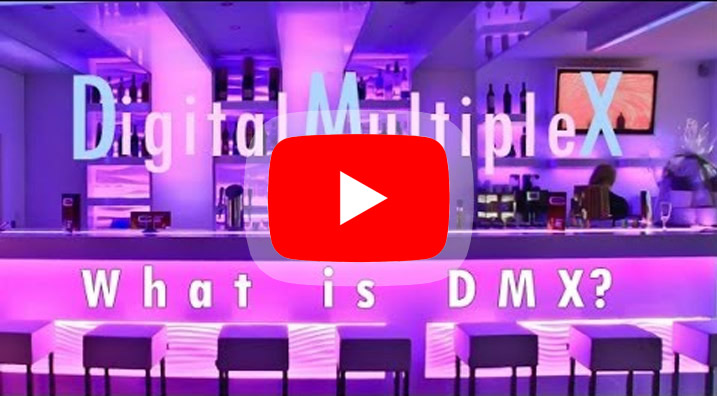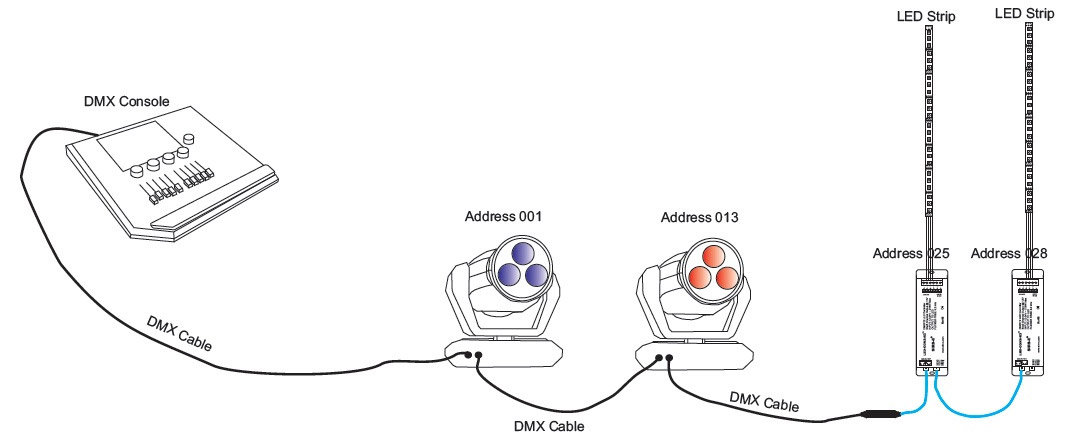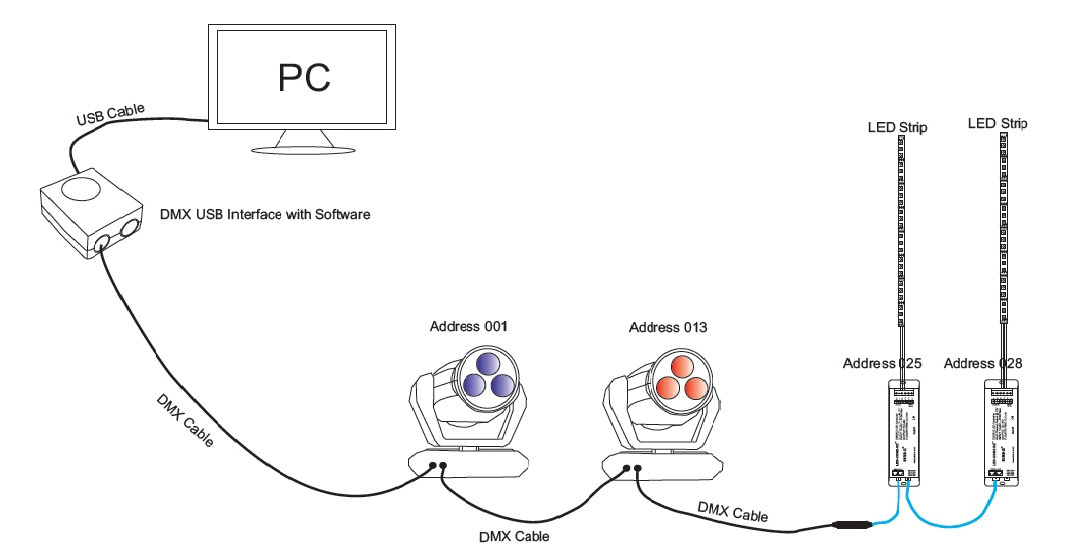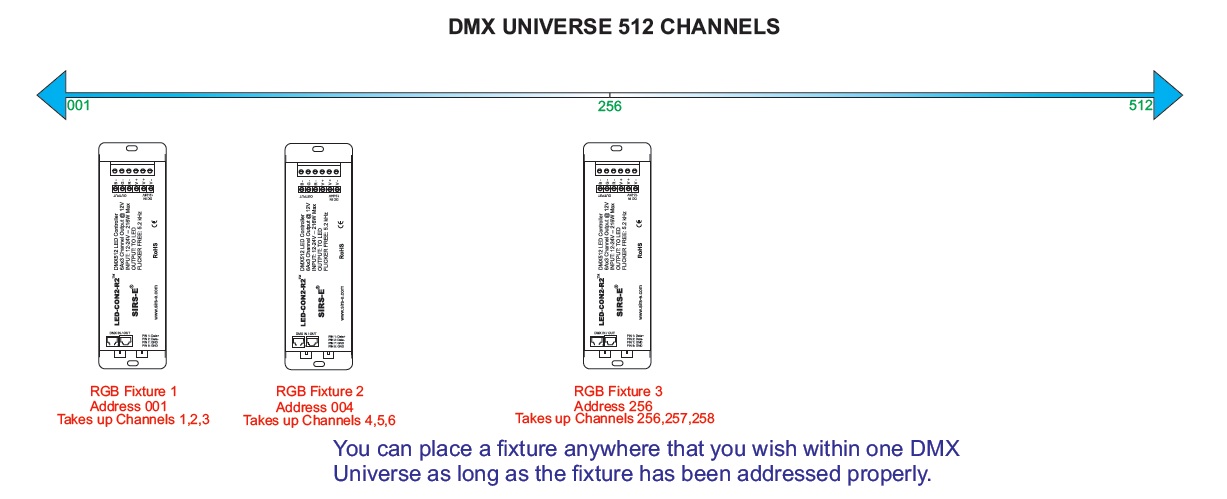DMX is a lighting control protocol which allows users to have ultimate control over their lighting needs. Although it does not only apply to lighting, lighting is the most common use for DMX. DMX originated as a way to set the bar for lighting manufacturers to build fixtures that would all be compatible with each other, instead of having individual control stations for each set of lighting. This gave the Audio Visual industry a huge break because it allowed them to control everything from one single source giving them more freedom and flexibility when it came to creating lighting shows.
DMX requires different components to work. First off, you need a source to create DMX. This can be achieved by a computer interface that converts USB to DMX using a DMX software, which will allow you set infinite presets, and give you full control all with the click of a mouse.
There’s also the more traditional way to generate DMX through a DMX Console. This was one of the first ways that DMX originated. DMX consoles are a bit more limited than software because you have to manually trigger everything, and depending on the capability of the Console, performance may vary. Once you have your DMX signal origin, you will then need DMX fixtures.
There are all sorts of lighting fixtures that operate with DMX. After you have your entire fixtures daisy chained, or interlinked with each other, you must address them. Addressing fixtures will give them a start DMX channel which means that’s where the signal will be sent for that individual fixture. Each fixture will require an amount of channels to work, so depending on the amount of channels a fixture has, you will then address the rest of the fixtures on the next available channel after giving the previous fixture room to operate.
For example, an RGB fixture will require 3 DMX channels. If it addressed to channel 001, it will then take up channels 001, 002, and 003. The next free channel after that would be 004. You can also put 2 equal fixtures on the same address and they will both perform as one. You can use this technique to build your DMX line, or universe.
What is a DMX universe? Well a DMX universe is a set of channels, 512 to be precise on which DMX signals will operate. If more than one universe is required for a set up, then with the proper software, interface, and universe merging techniques it can all be done. Remember, DMX will give you ultimate control over your lighting needs, so why not use it?
DMX512 is a type of electric signal data protocol used in the lighting industry on stage or in residential setups to control a
series of light fixtures, LEDs, and other devices. This DMX512 protocol is in compliance with the standard set by the ESTA
(Entertainment Services Technology Association). In January 2011 the ESTA merged with PLASA, a similar organization from the UK.
and formed a new alliance called PLASA.
The fixtures are usually interlinked with each other using DMX cables, Usually 3 or 5 pin XLR. This technique is known as daisy
chain. Having a daisy chained DMX line allows the user to control each light fixture independently from the others with different
settings, working together.
DMX control is usually achieved with a DMX console, similar to an audio board, or with DMX software on which a show can be recorded and scenes can be built and edited. This software is connected with a DMX USB interface that converts USB output to DMX output. There is also the possibility to set up an Ethernet network that controls DMX by using an Ethernet over DMX interface. This type of setup is used for iPad DMX apps which wirelessly control a DMX line. DMX computer software similar to that of the USB to DMX Interfaces can also be used with DMX over Ethernet interfaces to eliminate the cable that goes from the interface to the first DMX fixture by sending DMX signals through the air via WIFI. There are different DMX over Ethernet protocols such as ArtNet, PathPort, ShowNet, ACN and ETC Net2, Just to name a few. Either of these protocols can be used depending on what the application calls for.
DMX protocol is divided into what is called Universes. A standard DMX universe consists of 512 channels. Most lighting fixtures, DMX LED drivers and so on are addressable. They have a series of Dip switches which have an on or off position. The switches are numbered 1-10 which are then selected either on or off in a binary code fashion to reach the desired addresses. Other fixtures may also have digital displays which makes addressing a lot easier since addressing is done by navigating through the available channels like you would on a TV, clicking up or down on the channel selection.
When addressing fixtures, you need to keep in mind how many channels the controller or fixture you are using is. For example, the LED-CON2 which is a 3 channel RGB LED driver, therefore if you will be linking 2 of these together the first controller must be on address 1 and the second one must be in address 4. The first controller will be taking channels 1, 2, and 3 in order to function. Since these channels are unused it will work correctly. The second controller if you do not wish for it to take the same commands as the first controller, you will need to address it to an open channel, or address. In this case channel 4 is open because we already used channels 1, 2, and 3 for the first controller. So now channels 4, 5, and 6 will be for the second controller.
This is the basic information of a DMX controller and how it works. Following these techniques will allow you to do bigger and more
professional setups.





